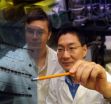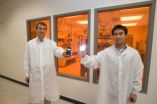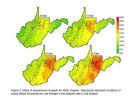(Press-News.org) Therapeutic antibodies can be an efficient alternative when common drugs do not work anymore. However, antibodies obtained from blood of animals such as mice could not be used: The human immune system recognizes them as foreign and rejects them. In an international cooperation, scientists from the Helmholtz Centre for Infection Research (HZI) in Braunschweig, Germany have now succeeded in developing a promising approach to solve this problem; with the help of human stem cells they generated mice with a human immune system, which were then vaccinated to produce human monoclonal antibodies. These fully human antibodies could help in the research and therapy of human diseases. Their results have now been published in the current online issue of the scientific journal "PLoS One".
Antibodies are small proteins, produced by B cells during an immune response. They bind at and thus mark invading pathogens so that scavenger cells recognize and destroy them. "The task of our immune system is to distinguish between self and non-self structures," says Professor Carlos A. Guzmàn, head of the department of "Vaccinology and Applied Microbiology" at the HZI. "This means also that only human antibodies come into question for an antibody therapy", since the human immune system fights antibodies from mice – a threat for the patient. Furthermore, it is cumbersome to humanize murine antibodies for human treatment or to generate human B cell clones producing high quantities of antibodies.
The scientists used an already established method to give a human immune system to mice, which were then exploited to solve this problem: they injected human stem cells into young mice that due to a genetic defect lack an immune system. The stem cells migrate into the bone marrow, proliferate, differentiate and lead to the generation of a human immune system. "In our in-depth investigations we were able to detect all important types of immune cells in these mice," says Dr. Pablo Becker, scientist in the HZI department "Vaccinology and Applied Microbiology".
To validate the new approach, mice with a human immune system were vaccinated against Hepatitis B or Tetanus. The scientists then isolated human antibody producing B cells from the mice and treated them so that they survive outside the body in a cell culture dish and continue producing antibodies. Then, the researchers took a deeper look at the antibodies. The results give hope: "Antibodies from mice with a human immune system showed good properties in our tests, but the model still needs to be improved for broad implementation in biomedicine," says Pablo Becker. "However, we were able to demonstrate for the first time that it is possible to produce human monoclonal antibodies using humanized mice." Now it is important to improve this mouse model to use it one day for the development of advanced therapies against human diseases. "In the future this approach might represent the most powerful tool to develop therapeutic antibodies for clinical use," hopes Becker.
INFORMATION:
Original Article: Becker PD, Legrand N, van Geelen CMM, Noerder M, Huntington ND, et al. 2010. Generation of Human Antigen-Specific Monoclonal IgM Antibodies Using Vaccinated "Human Immune System" Mice. PLoS ONE 5(10): e13137. doi:10.1371/journal.pone.0013137
Mice with human body's defenses
New method will simplify study and treatment of diseases
2010-10-06
ELSE PRESS RELEASES FROM THIS DATE:
Powerful free radical causes lung damage from oxygen therapy
2010-10-06
AUGUSTA, Ga. – The most toxic free radical appears responsible for much of the lung damage that can result from oxygen therapy in the critically ill or injured, Medical College of Georgia researchers report.
Within just a few days, ventilators and oxygen chambers used to significantly increase oxygen levels can also dramatically increase levels of peroxynitrite, an oxidant powerful enough to break down DNA and cause proteins to malfunction, said Dr. Yunchao Su, pharmacologist in the MCG Schools of Medicine and Graduate Studies.
Oxygen toxicity is the most severe side ...
Is your job making you fat?
2010-10-06
Montreal, October 05, 2010 – Working nine-to-five may be the way to make a living, but it may be padding more than the wallet. According to a new study from the Université de Montréal, office-workers have become less active over the last three decades and this decreased activity may partly explain the rise in obesity. Their findings, published in the early online edition of Preventive Medicine, may have health implications for the millions of people toiling behind their desks.
"People eat better and exercise more today than they did in the 1970's, yet obesity rates ...
Breakthrough e-display means electronics with high speed, high readability and low power usage
2010-10-06
Today's Oct. 4 issue of the high-impact journal, Applied Physics Letters, contains a new electrofluidics design from the University of Cincinnati and start-up company Gamma Dynamics that promises to dramatically reshape the image capabilities of electronic devices.
This patent-pending electrofluidics breakthrough by the Novel Devices Laboratory at the University of Cincinnati and partner companies Gamma Dynamics, Dupont and Sun Chemical follows about seven years of work. According to lead researcher Jason Heikenfeld, UC associate professor of electrical and computer engineering ...
Fish oil linked to increased risk of colon cancer in mice
2010-10-06
EAST LANSING, Mich. — Fish oil – long encouraged by doctors as a supplement to support heart and joint health, among other benefits – induced severe colitis and colon cancer in mice in research led by Michigan State University and published this month in the journal Cancer Research.
Jenifer Fenton, a food science and human nutrition researcher at MSU, led the research that supports establishing a dose limit for docosahexaenoic acid (DHA), one of the omega-3 fatty acids present in fish oil, particularly in people suffering from chronic conditions such as inflammatory bowel ...
'Paradigm shift' in how physicians treat peripheral artery disease
2010-10-06
A balloon angioplasty device that sucks up dangerous plaque debris could trigger a "paradigm shift" in how physicians treat peripheral artery disease, researchers write in the current issue of Endovascular Today.
"We will see a shift in how we treat lesions," write Dr. Robert Dieter of Loyola University Health System and Dr. Aravinda Nanjundappa of West Virginia University.
In two clinical trials totaling 123 patients, the device had a success rate of 97 percent to 99 percent and consistently outperformed filter devices typically used to capture debris particles, Dieter ...
Shortfalls in carotenoid intake may impact women's health
2010-10-06
GRAND RAPIDS, MICH., Oct. 5, 2010 – Only about a third of American women are meeting their fruit and vegetable intake recommendations, which means they are likely missing out on potentially important breast and ovarian health benefits (1). Along with vitamins, minerals and fiber, fruits and vegetables contain a type of phytonutrient called carotenoids, which research suggests help support women's health including breast and ovarian health.
Based on a new report called America's Phytonutrient Report: Women's Health by Color, older women have total carotenoid intakes ...
ORNL uses new technologies to take steam out of wasted energy
2010-10-06
OAK RIDGE, Tenn., Oct. 5, 2010 -- By installing wireless sensors and replacing faulty traps along the 12 miles of steam lines at Oak Ridge National Laboratory, officials expect to save as much as $675,000 per year.
With 1,600 steam traps, which normally open slightly to discharge condensed steam with a negligible loss of live steam, the problem occurs when a trap fails and that failure goes undetected and unrepaired, said Teja Kuruganti, a member of the Computational Sciences and Engineering Division.
Manual inspections of each trap is a daunting and sometimes dangerous ...
SMU geothermal mapping project reveals large, green energy source in coal country
2010-10-06
DALLAS (SMU) – New research produced by Southern Methodist University's Geothermal Laboratory, funded by a grant from Google.org, suggests that the temperature of the Earth beneath the state of West Virginia is significantly higher than previously estimated and capable of supporting commercial baseload geothermal energy production.
Geothermal energy is the use of the Earth's heat to produce heat and electricity. "Geothermal is an extremely reliable form of energy, and it generates power 24/7, which makes it a baseload source like coal or nuclear," said David Blackwell, ...
Sediment pollution should be included in water quality assessment
2010-10-06
Under the Water Framework Directive (WFD) (Directive 2000/60/CE), member states are required to achieve Good Water Status for water (continental, estuarine, subterranean and coastal water bodies) in Europe by 2015. Surface water quality is assessed taking into account the ecological and chemical status.
The quality of aquatic systems is more accurately assessed using the status of both the water column and the underlying sediment. A recent study by researchers of AZTI-Tecnalia concluded that water bodies risk being misclassified if, on evaluating their chemical status, ...
New graphene fabrication method uses silicon carbide templates to create desired growth
2010-10-06
Researchers at the Georgia Institute of Technology have developed a new "templated growth" technique for fabricating nanometer-scale graphene devices. The method addresses what had been a significant obstacle to the use of this promising material in future generations of high-performance electronic devices.
The technique involves etching patterns into the silicon carbide surfaces on which epitaxial graphene is grown. The patterns serve as templates directing the growth of graphene structures, allowing the formation of nanoribbons of specific widths without the use of ...
LAST 30 PRESS RELEASES:
Why nail-biting, procrastination and other self-sabotaging behaviors are rooted in survival instincts
Regional variations in mechanical properties of porcine leptomeninges
Artificial empathy in therapy and healthcare: advancements in interpersonal interaction technologies
Why some brains switch gears more efficiently than others
UVA’s Jundong Li wins ICDM’S 2025 Tao Li Award for data mining, machine learning
UVA’s low-power, high-performance computer power player Mircea Stan earns National Academy of Inventors fellowship
Not playing by the rules: USU researcher explores filamentous algae dynamics in rivers
Do our body clocks influence our risk of dementia?
Anthropologists offer new evidence of bipedalism in long-debated fossil discovery
Safer receipt paper from wood
Dosage-sensitive genes suggest no whole-genome duplications in ancestral angiosperm
First ancient human herpesvirus genomes document their deep history with humans
Why Some Bacteria Survive Antibiotics and How to Stop Them - New study reveals that bacteria can survive antibiotic treatment through two fundamentally different “shutdown modes”
UCLA study links scar healing to dangerous placenta condition
CHANGE-seq-BE finds off-target changes in the genome from base editors
The Journal of Nuclear Medicine Ahead-of-Print Tip Sheet: January 2, 2026
Delayed or absent first dose of measles, mumps, and rubella vaccination
Trends in US preterm birth rates by household income and race and ethnicity
Study identifies potential biomarker linked to progression and brain inflammation in multiple sclerosis
Many mothers in Norway do not show up for postnatal check-ups
Researchers want to find out why quick clay is so unstable
Superradiant spins show teamwork at the quantum scale
Cleveland Clinic Research links tumor bacteria to immunotherapy resistance in head and neck cancer
First Editorial of 2026: Resisting AI slop
Joint ground- and space-based observations reveal Saturn-mass rogue planet
Inheritable genetic variant offers protection against blood cancer risk and progression
Pigs settled Pacific islands alongside early human voyagers
A Coral reef’s daily pulse reshapes microbes in surrounding waters
EAST Tokamak experiments exceed plasma density limit, offering new approach to fusion ignition
Groundbreaking discovery reveals Africa’s oldest cremation pyre and complex ritual practices
[Press-News.org] Mice with human body's defensesNew method will simplify study and treatment of diseases


